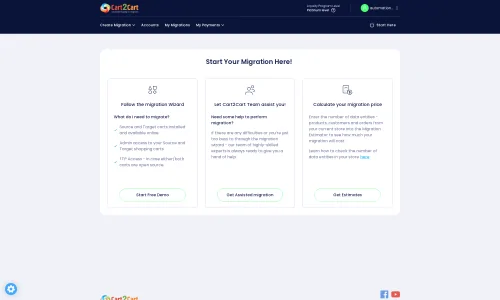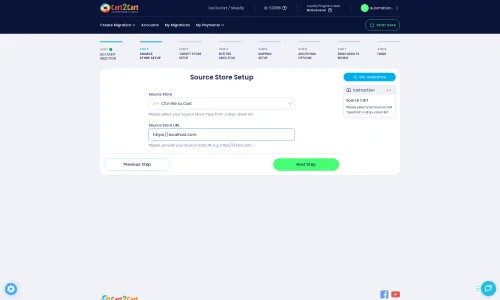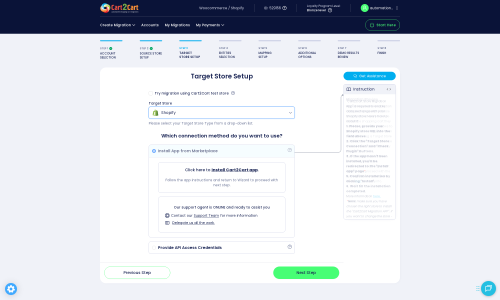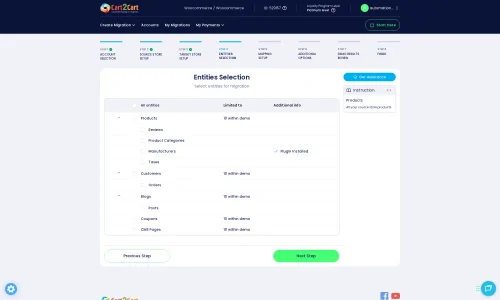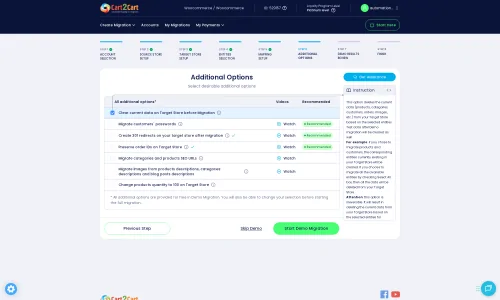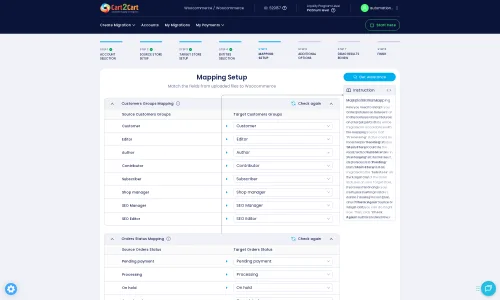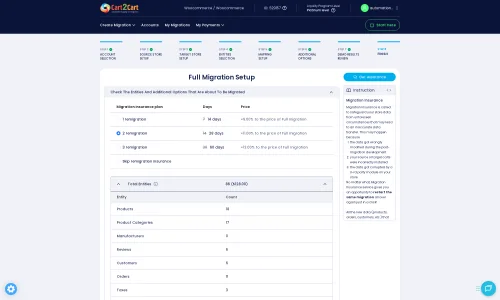Solid Commerce to Shopify Migration - Step-by-Step Guide & Expert Services
Solid Commerce to Shopify migration is your next smart move. Ready to upgrade your eCommerce potential? Cart2Cart simplifies how you move Solid Commerce store to Shopify. We make the switch from Solid Commerce to Shopify efficient and secure, ensuring flawless data transfer. Preserve your valuable SEO rankings and experience zero downtime. Whether you need a detailed step-by-step guide for a DIY approach or professional expert help, we make your Solid Commerce to Shopify migration smooth and successful.
What data can be
migrated from Solid Commerce to Shopify
-
Products
-
Product Categories
-
Manufacturers
-
Customers
-
Orders
Estimate your Migration Cost
The price of your migration depends on the volume of data to migrate and the additional migration options you pick. To check the price for Solid Commerce to Shopify conversion, click “Get estimates” and follow the suggested steps.
How to Migrate from Solid Commerce to Shopify In 3 Steps?
Connect your Source & Target carts
Choose Solid Commerce and Shopify from the drop-down lists & provide the stores’ URLs in the corresponding fields.
Select the data to migrate & extra options
Choose the data you want to migrate to Shopify and extra options to customise your Solid Commerce to Shopify migration.
Launch your Demo/Full migration
Run a free Demo to see how the Cart2Cart service works, and when happy - launch Full migration.
Migrate Solid Commerce to Shopify: Your Definitive How-To Guide
Seamlessly Migrate Your E-commerce Store from Solid Commerce to Shopify
Replatforming your e-commerce store is a significant undertaking, but moving from Solid Commerce to a robust platform like Shopify can unlock new opportunities for growth, enhanced features, and a more streamlined management experience. Shopify is renowned for its user-friendly interface, extensive app ecosystem, and scalability, making it an excellent choice for merchants looking to modernize their online presence.
Given that Solid Commerce does not offer a direct, native API connection for data migration, this guide will walk you through the process of transferring your store's vital information to Shopify using a CSV file export from Solid Commerce, followed by an efficient migration wizard (such as Cart2Cart) for importing that data into your new Shopify store. This ensures a comprehensive and accurate data transfer, preserving your valuable customer, product, and order information.
Prerequisites for a Successful Migration
Before initiating your store's transition, it's crucial to prepare both your Solid Commerce (source) and Shopify (target) environments to ensure a smooth and error-free data transfer.
For Your Solid Commerce (Source) Store:
- Administrative Access: Ensure you have full administrative access to your Solid Commerce account to export all necessary data.
- Data Export: Prepare to export your critical store data into CSV (Comma Separated Values) files. This includes: Products (with variants, SKUs, images, descriptions), Product Categories, Manufacturers, Customer Data, Orders (with statuses, customer details), Invoices, Taxes, Coupons, CMS Pages, and Blog Posts. Organize these files clearly for easy upload.
- Data Cleanup: Take this opportunity to clean up old or redundant data. Removing outdated products, customer records, or unused coupons now will result in a cleaner, more efficient Shopify store.
- Backup Your Data: Always create a complete backup of your Solid Commerce store data before starting any migration process.
For more details on preparing your source store, read our How to prepare Source store for migration? guide.
For Your Shopify (Target) Store:
- Shopify Account: You need an active Shopify store. This could be a new store or an existing one. Ensure it's on a suitable plan (e.g., Basic Shopify, Advanced Shopify, Shopify Plus) to accommodate your business needs.
- Cart2Cart Store Migration App: To facilitate the data import process, you will need to install the Cart2Cart Store Migration App from the Shopify App Store. This app acts as the bridge between your exported Solid Commerce data and your new Shopify store.
- Disable Notifications: It's highly recommended to disable order and customer notifications in your Shopify admin settings temporarily during the migration. This prevents customers from receiving premature or duplicate emails during the data import.
- Consider a 'Pause and Build' Plan: If you're building a new Shopify store, be aware that a 'Pause and Build' plan might temporarily block order processing. Plan your migration timing accordingly to minimize any potential downtime.
- Reviews App: If you intend to migrate product reviews, be aware that Shopify often requires a dedicated reviews app (e.g., AirReviews) to display them correctly. Plan to install a compatible app.
- API Access (Optional): While the Cart2Cart app is the recommended connection method, manual API access is an alternative. This requires creating a custom app in your Shopify admin, configuring necessary API scopes (e.g., for products, customers, orders), and obtaining an Admin API access token. For guidance on credentials, refer to The Short & Essential Guide to Access Credentials for Cart2Cart.
For additional details, see our How to prepare Target store for migration? FAQ.
Performing the Migration: A Step-by-Step Guide
This section outlines the detailed steps to perform your Solid Commerce to Shopify migration using a migration wizard.
Step 1: Get Started with the Migration Wizard
Begin your migration journey by navigating to the migration wizard interface. This is typically the starting point where you can choose to begin a do-it-yourself migration.
Step 2: Connect Your Solid Commerce (CSV) Source Store
In the wizard, you will select your source platform. Since Solid Commerce data will be provided via files, choose "CSV File to Cart" as your Source Cart type from the dropdown menu.
Next, you will be prompted to upload the CSV files containing your exported Solid Commerce data. Ensure your files are correctly formatted and contain all the entities you wish to migrate.
Step 3: Connect Your Shopify Target Store
Now, select "Shopify" as your Target Cart type. The recommended and most straightforward connection method is to "Install App from Marketplace". Click the provided link, follow the instructions to install the Cart2Cart migration app on your Shopify store, and then return to the wizard.
Alternatively, you can choose to "Provide API Access Credentials" if you prefer a manual setup. This will require you to enter your Shopify store URL and the Admin API access token that you generated from a custom app in your Shopify admin.
Step 4: Select Entities for Data Transfer
This crucial step allows you to specify exactly what data you want to move from Solid Commerce to Shopify. You can choose to migrate all available entities or select specific ones based on your needs. Commonly migrated entities include:
- Products (including variants, images, descriptions, SKUs)
- Product Categories
- Customers
- Orders
- Product Reviews
- CMS Pages
- Gift Cards
- Coupons
- Blogs & Blog Posts
Review the counts for each entity to ensure all expected data is identified for transfer.
Step 5: Configure Additional Migration Options
Enhance your migration with a variety of additional options tailored to optimize data transfer and preserve important store attributes. These often include:
- Clear Target Store Data: This option clears existing data on your Shopify store before the migration, ideal for new stores.
- Preserve Order IDs: Maintain your original order numbering, crucial for accounting and record-keeping. Learn more about how Preserve IDs options can be used.
- Migrate Images in Description: Ensures all product and category images embedded within descriptions are transferred.
- Create 301 SEO URLs: This vital option automatically sets up redirects from your old Solid Commerce URLs to your new Shopify URLs, preserving your SEO rankings and link equity.
- Migrate All Categories: Ensures your entire category structure is moved.
- Migrate Groups to Tags: Maps customer groups or other similar structures to Shopify's tagging system.
- Concat Short Description: Combines short and full descriptions if desired.
Step 6: Map Data Fields
The mapping setup ensures consistency between your source and target stores. This step involves matching various fields from your Solid Commerce data (from CSV) to their corresponding counterparts in Shopify. Key mapping tasks include:
- Customer Group Mapping: Assign Solid Commerce customer groups to existing or new customer roles/tags in Shopify.
- Order Status Mapping: Match your Solid Commerce order statuses (e.g., 'Processing,' 'Completed,' 'Refunded') to Shopify's equivalent statuses.
- Product Attribute Mapping: Ensure product attributes and variants are correctly aligned.
Accurate data mapping is critical for maintaining data integrity and ensuring your new store functions as expected.
Step 7: Run a Free Demo Migration (Highly Recommended)
Before committing to a full migration, execute a free demo. This transfers a limited number of entities (e.g., 10-20 products, customers, orders) to your Shopify store. The demo allows you to:
- Verify the connection between platforms.
- Check data integrity and formatting.
- Identify potential issues or mapping errors early.
- Familiarize yourself with the migration process.
Step 8: Perform Full Data Migration
Once you are satisfied with the demo results and have reviewed all your settings and selected options, proceed with the full data migration. This will transfer all chosen entities from your Solid Commerce CSV files to your Shopify store.
Consider adding a Migration Insurance Plan, which offers remigrations for a specified duration, providing peace of mind in case any unforeseen issues arise or you need to transfer new data later. Learn more about how Migration Insurance works.
Post-Migration Steps: Activating Your Shopify Store
Completing the data transfer is a major milestone, but several critical steps remain to ensure your new Shopify store is fully functional and optimized.
- Thorough Data Verification: Rigorously check all migrated data in your Shopify admin. Verify product details, pricing, inventory levels, customer accounts, order histories, CMS pages, and blog posts. Pay special attention to product images and variants.
- Configure Shopify Essentials:
- Choose and Customize a Theme: Select a suitable theme from the Shopify Theme Store and customize it to match your brand identity.
- Set Up Payment Gateways: Configure your preferred payment methods (e.g., Shopify Payments, PayPal, Stripe).
- Configure Shipping Zones and Rates: Define your shipping options and prices.
- Install Essential Apps: Browse the Shopify App Store for apps that extend functionality, such as SEO tools, marketing integrations, customer support, or additional review apps if you migrated reviews.
- Set Up Email Notifications: Customize and enable your order, shipping, and customer account notification emails.
- Update DNS Settings: Point your domain name to your new Shopify store. This step is crucial for making your new store live.
- Implement 301 Redirects: While the migration wizard offers an option for 301 redirects, double-check that all critical URLs from your old Solid Commerce store are redirecting correctly to their new Shopify counterparts. This is essential for preserving your SEO rankings and providing a seamless user experience.
- Perform Comprehensive Testing: Conduct extensive tests across your entire store.
- Checkout Process: Test purchases from product selection to payment and order confirmation.
- Customer Accounts: Verify login, password reset, and order history access.
- Search Functionality: Ensure products and content are easily discoverable.
- Forms: Test contact forms, newsletter sign-ups.
- Mobile Responsiveness: Check how your store appears and functions on various devices.
- Integrate Analytics: Set up and verify Google Analytics and any other tracking tools to monitor your store's performance.
- Inform Your Customers: Announce your new and improved store to your customer base, highlighting any new features or benefits.
- Ongoing SEO Monitoring: Keep a close eye on your search engine performance using tools like Google Search Console to address any crawl errors or ranking fluctuations post-migration.
By following these detailed steps, you can confidently transition your e-commerce business from Solid Commerce to Shopify, paving the way for future growth and success.
Ways to perform migration from Solid Commerce to Shopify
Automated migration
Just set up the migration and choose the entities to move – the service will do the rest.
Try It Free
Data Migration Service Package
Delegate the job to the highly-skilled migration experts and get the job done.
Choose Package

Benefits for Store Owners

Benefits for Ecommerce Agencies
Choose all the extra migration options and get 40% off their total Price

The design and store functionality transfer is impossible due to Solid Commerce to Shopify limitations. However, you can recreate it with the help of a 3rd-party developer.
Your data is safely locked with Cart2Cart
We built in many security measures so you can safely migrate from Solid Commerce to Shopify. Check out our Security Policy
Server Security
All migrations are performed on a secure dedicated Hetzner server with restricted physical access.Application Security
HTTPS protocol and 128-bit SSL encryption are used to protect the data being exchanged.Network Security
The most up-to-date network architecture schema, firewall and access restrictions protect our system from electronic attacks.Data Access Control
Employee access to customer migration data is restricted, logged and audited.Frequently Asked Questions
Should I use an automated tool or hire an expert for Solid Commerce to Shopify migration?
What factors influence the cost of migrating from Solid Commerce to Shopify?
How long does a Solid Commerce to Shopify migration take?
How can I ensure data accuracy after migrating from Solid Commerce to Shopify?
What data entities are migrated from Solid Commerce to Shopify?
Is my data secure when migrating from Solid Commerce to Shopify?
Will my Solid Commerce store's design or theme transfer to Shopify?
Will my Solid Commerce store go offline during migration to Shopify?
Can customer passwords be migrated from Solid Commerce to Shopify?
How can I keep SEO rankings when switching from Solid Commerce to Shopify?
Why 150.000+ customers all over the globe have chosen Cart2Cart?
100% non-techie friendly
Cart2Cart is recommended by Shopify, WooCommerce, Wix, OpenCart, PrestaShop and other top ecommerce platforms.
Keep selling while migrating
The process of data transfer has no effect on the migrated store. At all.
24/7 live support
Get every bit of help right when you need it. Our live chat experts will eagerly guide you through the entire migration process.
Lightning fast migration
Just a few hours - and all your store data is moved to its new home.
Open to the customers’ needs
We’re ready to help import data from database dump, csv. file, a rare shopping cart etc.
Recommended by industry leaders
Cart2Cart is recommended by Shopify, WooCommerce, Wix, OpenCart, PrestaShop and other top ecommerce platforms.



